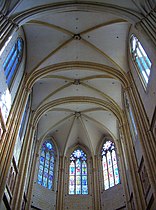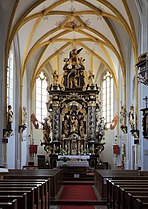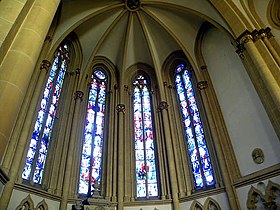Five-eighth ending
The five -eighth closure (also: five-eighth closure or 5 ⁄ 8 closure ) is a variant of the polygonal closure of a choir in church architecture .
description
From the floor plan as a regular octagon -scale form of the choir five-eighths to be built; the other three sides of the octagon form the opening towards the choir and nave .
In the case of a long choir, in which the side walls are longer than the octagonal sides of the choir closure, the parallel outer built-over sides of the octagon can also be counted towards the side walls, after the remaining three sides the designation three -eighth closure (or three-eighths) Closing or 3 ⁄ 8 closing ).
The five - eighth key was preferred in Gothic and Neo-Gothic church architecture in continental Western Europe .
variants
The 7 ⁄ 10 end (e.g. at the Elisabethkirche in Marburg ), the 7 ⁄ 12 end ("Hasenkamp" at the Paderborn Cathedral ) or the 9 ⁄ 14 end (am Aachen Cathedral ).
The English Gothic, however, preferred the rectangular choir . A rectangular choir or a (half) round end of the choir already marked the Romanesque church building.
Examples of the choir degrees mentioned
Five-eighths end of Dijon Cathedral
Three-eighths end of the Waldzell parish church
7 ⁄ 10 -Closure of the Elisabethkirche Marburg
7 ⁄ 12 closing at Paderborn Cathedral
9 ⁄ 14 close at Aachen Cathedral
literature
- Wilfried Koch : Architectural style. European architecture from antiquity to the present. Special edition. Orbis Verlag, Munich 1988, ISBN 3-572-05927-5 , p. 403.
- Wilfried Koch: A brief history of architecture. Bertelsmann, Gütersloh 1967, pp. 95–96 ( small advice books , several editions).





